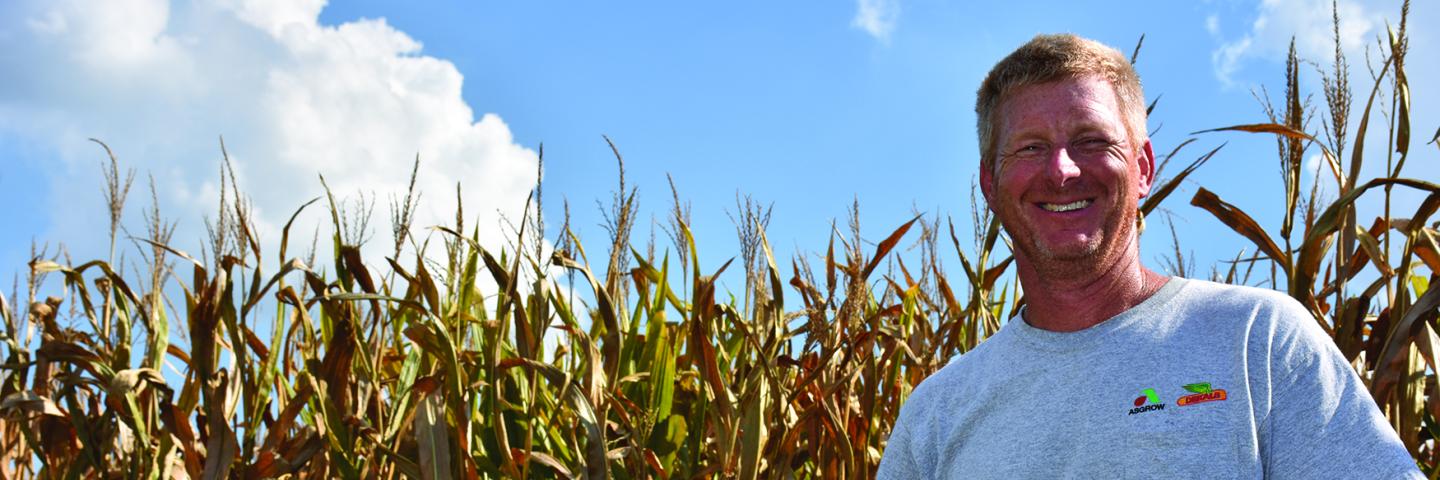Indiana Farmer Works with NRCS to Reclaim Mined Land

As a fifth-generation farmer, Joe Keusch knows a thing or two about his land. And, his 110-year-old farm located in the Ell Creek Watershed is a little different than most in Indiana.
As a fifth-generation farmer, Joe Keusch knows a thing or two about his land. And, his 110-year-old farm located in the Ell Creek Watershed is a little different than most in Indiana.
A portion of Keusch’s farm is part of a former coal mine. Sediment runoff is a great concern on mined lands, because they lack the vegetative cover and topsoil to infiltrate, filter, or slow down runoff. When the mine was reclaimed as farmland, Keusch struggled with getting his soil health up to par.
“Anyone that has ever dealt with coal mine ground knows it’s very finicky in the way it behaves – not only with growing a crop but the way it handles water,” Keusch said. “Seeing wash outs and sheet erosion on the old mine ground was hard to watch.”
Three years ago, Keusch enlisted the help of his USDA’s Natural Resources Conservation Service (NRCS) District Conservationist Bart Pitstick and was introduced to the agency’s National Water Quality Initiative (NWQI) program.
Keusch and Pitstick walked the family farm to talk about natural resource concerns and goals for the land and together they developed a comprehensive conservation plan to make the farm more productive and sustainable.
“I knew I wanted to address the coal mine land,” Keusch said. “When that topsoil is sitting in a pile for eight years during the mining process, it becomes stale with very little microbiological growth in it. That’s the biggest challenge when working with reclaimed mine land.”
Keusch started his conservation planning process by adding cover crops on the reclaimed land. In three short years, the microbiological activity was returning to the land.
“I went out to the farm and pulled up a clump of dirt and it had earth worms all over it,” stated Keusch. “I couldn’t believe it.”
Keusch and Pitstick are already working on the next phase of his conservation plan. In addition to cover crops, his new NWQI contract involves implementing a number of conservation practices over the next few years that will improve water quality not only on the farm but in the entire community, including critical area planting, diversion, mulching, subsurface drain, amending soil properties with gypsiferous products, grade stabilization structure, grassed waterway, nutrient management, and a structure for water control.
When asked what the biggest benefit from enrolling in NWQI was, Keusch responded "The history of this farm is vast and my dad was a firm believer in leaving something better than the way it was when you found it. Seeing the ground continue to improve year after year with more organic matter and less erosion is rewarding. If I continue with that mind-set, I hope my son or my daughter will eventually take over and be the sixth generation on the farm.”
Additional Information
Soil Health - Indiana
Indiana farmers are on a health kick! Healthy soil is managed to its maximum potential through a system of conservation practices, including no-till, cover crops, advanced nutrient and pest management, and buffers and drainage systems where appropriate.
Learn MoreEnvironmental Quality Incentives Program - Indiana
The Environmental Quality Incentives Program (EQIP) provides financial and technical assistance to agricultural producers and non-industrial forest managers to conserve natural resources while strengthening their operations.
Learn MoreINDIANA NRCS HOMEPAGE
For more information about NRCS programs offered in Indiana and how experts throughout the state can help you address natural resource concerns on your land, visit the Indiana NRCS homepage.

